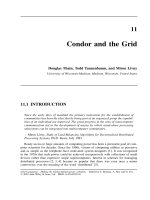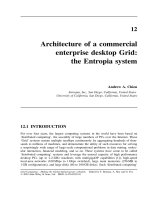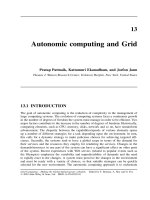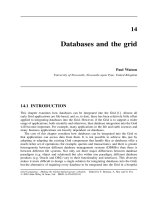Tài liệu Grid Computing P21 ppt
Bạn đang xem bản rút gọn của tài liệu. Xem và tải ngay bản đầy đủ của tài liệu tại đây (162.68 KB, 24 trang )
21
Grid programming models:
current tools, issues and directions
Craig Lee
1
and Domenico Talia
2
1
The Aerospace Corporation, California, United States,
2
Universit´a della Calabria, Rende, Italy
21.1 INTRODUCTION
The main goal of Grid programming is the study of programming models, tools, and
methods that support the effective development of portable and high-performance algo-
rithms and applications on Grid environments. Grid programming will require capabili-
ties and properties beyond that of simple sequential programming or even parallel and
distributed programming. Besides orchestrating simple operations over private data struc-
tures, or orchestrating multiple operations over shared or distributed data structures, a
Grid programmer will have to manage a computation in an environment that is typically
open-ended, heterogeneous, and dynamic in composition with a deepening memory and
bandwidth/latency hierarchy. Besides simply operating over data structures, a Grid pro-
grammer would also have to design the interaction between remote services, data sources,
and hardware resources. While it may be possible to build Grid applications with current
programming tools, there is a growing consensus that current tools and languages are
insufficient to support the effective development of efficient Grid codes.
Grid Computing – Making the Global Infrastructure a Reality. Edited by F. Berman, A. Hey and G. Fox
2003 John Wiley & Sons, Ltd ISBN: 0-470-85319-0
556
CRAIG LEE AND DOMENICO TALIA
Grid applications will tend to be heterogeneous and dynamic, that is, they will run
on different types of resources whose configuration may change during run time. These
dynamic configurations could be motivated by changes in the environment, for example,
performance changes or hardware failures, or by the need to flexibly compose virtual
organizations [1] from any available Grid resources. Regardless of their cause, can a
programming model or tool give those heterogeneous resources a common ‘look-and-
feel’ to the programmer, hiding their differences while allowing the programmer some
control over each resource type if necessary? If the proper abstraction is used, can such
transparency be provided by the run-time system? Can discovery of those resources be
assisted or hidden by the run-time system?
Grids will also be used for large-scale, high-performance computing. Obtaining high
performance requires a balance of computation and communication among all resources
involved. Currently, this is done by managing computation, communication, and data
locality using message passing or remote method invocation (RMI) since they require the
programmer to be aware of the marshalling of arguments and their transfer from source
to destination. To achieve petaflop rates on tightly or loosely coupled Grid clusters of
gigaflop processors, however, applications will have to allow extremely large granularity
or produce upwards of approximately
10
8
-way parallelism such that high latencies can be
tolerated. In some cases, this type of parallelism, and the performance delivered by it in
a heterogeneous environment, will be manageable by hand-coded applications.
In light of these issues, we must clearly identify where current programming models are
lacking, what new capabilities are required, and whether they are best implemented at the
language level, at the tool level, or in the run-time system. The term programming model
is used here since we are not just considering programming languages. A programming
model can be present in many different forms, for example, a language, a library API,
or a tool with extensible functionality. Hence, programming models are present in frame-
works, portals, and problem-solving environments, even though this is typically not their
main focus. The most successful programming models will enable both high performance
and the flexible composition and management of resources. Programming models also
influence the entire software life cycle: design, implementation, debugging, operation,
maintenance, and so on. Hence, successful programming models should also facilitate
the effective use of all types of development tools, for example, compilers, debuggers,
performance monitors, and so on.
First, we begin with a discussion of the major issues facing Grid programming.
We then take a short survey of common programming models that are being used
or proposed in the Grid environment. We next discuss programming techniques and
approaches that can be brought to bear on the major issues, perhaps using the existing
tools.
21.2 GRID PROGRAMMING ISSUES
There are several general properties that are desirable for all programming models. Prop-
erties for parallel programming models have also been discussed in Reference [2]. Grid
programming models inherit all these properties. The Grid environment, however, will
GRID PROGRAMMING MODELS: CURRENT TOOLS, ISSUES AND DIRECTIONS
557
shift the emphasis on these properties dramatically to a degree not seen before and present
several major challenges.
21.2.1 Portability, interoperability, and adaptivity
Current high-level languages allowed codes to be processor-independent. Grid program-
ming models should enable codes to have similar portability. This could mean architecture
independence in the sense of an interpreted virtual machine, but it can also mean the ability
to use different prestaged codes or services at different locations that provide equiva-
lent functionality. Such portability is a necessary prerequisite for coping with dynamic,
heterogeneous configurations.
The notion of using different but equivalent codes and services implies interoperabil-
ity of programming model implementations. The notion of an open and extensible Grid
architecture implies a distributed environment that may support protocols, services, appli-
cation programming interface, and software development kits in which this is possible [1].
Finally, portability and interoperability promote adaptivity. A Grid program should be able
to adapt itself to different configurations based on available resources. This could occur
at start time, or at run time due to changing application requirements or fault recovery.
Such adaptivity could involve simple restart somewhere else or actual process and data
migration.
21.2.2 Discovery
Resource discovery is an integral part of Grid computing. Grid codes will clearly need to
discover suitable hosts on which to run. However, since Grids will host many persistent
services, they must be able to discover these services and the interfaces they support. The
use of these services must be programmable and composable in a uniform way. Therefore,
programming environments and tools must be aware of available discovery services and
offer a user explicit or implicit mechanisms to exploit those services while developing
and deploying Grid applications.
21.2.3 Performance
Clearly, for many Grid applications, performance will be an issue. Grids present heteroge-
neous bandwidth and latency hierarchies that can make it difficult to achieve high perfor-
mance and good utilization of coscheduled resources. The communication-to-computation
ratio that can be supported in the typical Grid environment will make this especially
difficult for tightly coupled applications.
For many applications, however, reliable performance will be an equally important
issue. A dynamic, heterogeneous environment could produce widely varying performance
results that may be unacceptable in certain situations. Hence, in a shared environment,
quality of service will become increasingly necessary to achieve reliable performance for
a given programming construct on a given resource configuration. While some users may
require an actual deterministic performance model, it may be more reasonable to provide
reliable performance within some statistical bound.
558
CRAIG LEE AND DOMENICO TALIA
21.2.4 Fault tolerance
The dynamic nature of Grids means that some level of fault tolerance is necessary. This
is especially true for highly distributed codes such as Monte Carlo or parameter sweep
applications that could initiate thousands of similar, independent jobs on thousands of
hosts. Clearly, as the number of resources involved increases, so does the probability
that some resource will fail during the computation. Grid applications must be able to
check run-time faults of communication and/or computing resources and provide, at the
program level, actions to recover or react to faults. At the same time, tools could assure
a minimum level of reliable computation in the presence of faults implementing run-time
mechanisms that add some form of reliability of operations.
21.2.5 Security
Grid codes will commonly run across multiple administrative domains using shared
resources such as networks. While providing strong authentication between two sites
is crucial, in time, it will not be uncommon that an application will involve multiple
sites all under program control. There could, in fact, be call trees of arbitrary depth in
which the selection of resources is dynamically decided. Hence, a security mechanism
that provides authentication (and privacy) must be integral to Grid programming models.
21.2.6 Program metamodels
Beyond the notion of just interface discovery, complete Grid programming will require
models about the programs themselves. Traditional programming with high-level lan-
guages relies on a compiler to make a translation between two programming models, that
is, between a high-level language, such as Fortran or C, and the hardware instruction set
presented by a machine capable of applying a sequence of functions to data recorded in
memory. Part of this translation process can be the construction of a number of models
concerning the semantics of the code and the application of a number of enhancements,
such as optimizations, garbage-collection, and range checking. Different but analogous
metamodels will be constructed for Grid codes. The application of enhancements, how-
ever, will be complicated by the distributed, heterogeneous Grid nature.
21.3 A BRIEF SURVEY OF GRID PROGRAMMING
TOOLS
How these issues are addressed will be tempered by both current programming practices
and the Grid environment. The last 20 years of research and development in the areas of
parallel and distributed programming and distributed system design has produced a body of
knowledge that was driven by both the most feasible and effective hardware architectures
and by the desire to be able to build systems that are more ‘well-behaved’ with properties
such as improved maintainability and reusability. We now provide a brief survey of many
specific tools, languages, and environments for Grids. Many, if not most, of these systems
GRID PROGRAMMING MODELS: CURRENT TOOLS, ISSUES AND DIRECTIONS
559
have their roots in ‘ordinary’ parallel or distributed computing and are being applied in
Grid environments because they are established programming methodologies. We discuss
both programming models and tools that are actually available today, and those that are
being proposed or represent an important set of capabilities that will eventually be needed.
Broader surveys are available in References [2] and [3].
21.3.1 Shared-state models
Shared-state programming models are typically associated with tightly coupled, syn-
chronous languages and execution models that are intended for shared-memory machines
or distributed memory machines with a dedicated interconnection network that provides
very high bandwidth and low latency. While the relatively low bandwidths and deep,
heterogeneous latencies across Grid environments will make such tools ineffective, there
are nonetheless programming models that are essentially based on shared state where the
producers and consumers of data are decoupled.
21.3.1.1 JavaSpaces
JavaSpaces [4] is a Java-based implementation of the Linda tuplespace concept, in which
tuples are represented as serialized objects. The use of Java allows heterogeneous clients
and servers to interoperate, regardless of their processor architectures and operating sys-
tems. The model used by JavaSpaces views an application as a collection of processes
communicating between them by putting and getting objects into one or more spaces.
A space is a shared and persistent object repository that is accessible via the network.
The processes use the repository as an exchange mechanism to get coordinated, instead
of communicating directly with each other. The main operations that a process can do
with a space are to put, take,andread (copy) objects. On a take or read operation,
the object received is determined by an associative matching operation on the type and
arity of the objects put into the space. A programmer that wants to build a space-based
application should design distributed data structures as a set of objects that are stored in
one or more spaces. The new approach that the JavaSpaces programming model gives to
the programmer makes building distributed applications much easier, even when dealing
with such dynamic, environments. Currently, efforts to implement JavaSpaces on Grids
using Java toolkits based on Globus are ongoing [5, 6].
21.3.1.2 Publish/subscribe
Besides being the basic operation underlying JavaSpaces, associative matching is a fun-
damental concept that enables a number of important capabilities that cannot be accom-
plished in any other way. These capabilities include content-based routing, event services,
and publish/subscribe communication systems [7]. As mentioned earlier, this allows the
producers and consumers of data to coordinate in a way in which they can be decoupled
and may not even know each other’s identity.
Associative matching is, however, notoriously expensive to implement, especially in
wide-area environments. On the other hand, given the importance of publish/subscribe
560
CRAIG LEE AND DOMENICO TALIA
to basic Grid services, such as event services that play an important role in support-
ing fault-tolerant computing, such a capability will have to be available in some form.
Significant work is being done in this area to produce implementations with acceptable
performance, perhaps by constraining individual instantiations to a single application’s
problem space. At least three different implementation approaches are possible [8]:
•
Network of servers: This is the traditional approach for many existing, distributed ser-
vices. The Common Object Request Broker Architecture (CORBA) Event Service [9]
is a prime example, providing decoupled communication between producers and con-
sumers using a hierarchy of clients and servers. The fundamental design space for
server-based event systems can be partitioned into (1) the local matching problem and
(2) broker network design [10].
•
Middleware: An advanced communication service could also be encapsulated in a
layer of middleware. A prime example here is A Forwarding Layer for Application-level
Peer-to-Peer Services (FLAPPS [11]). FLAPPS is a routing and forwarding middleware
layer in user-space interposed between the application and the operating system. It is
composed of three interdependent elements: (1) peer network topology construction
protocols, (2) application-layer routing protocols, and (3) explicit request forwarding.
FLAPPS is based on the store-and-forward networking model, in which messages and
requests are relayed hop-by-hop from a source peer through one or more transit peers
en route to a remote peer. Routing behaviors can be defined over an application-defined
namespace that is hierarchically decomposable such that collections of resources and
objects can be expressed compactly in routing updates.
•
Network overlays: The topology construction issue can be separated from the server/
middleware design by the use of network overlays. Network overlays have generally
been used for containment, provisioning,andabstraction [12]. In this case, we are
interested in abstraction, since network overlays can make isolated resources appear
to be virtually contiguous with a specific topology. These resources could be service
hosts, or even active network routers, and the communication service involved could
require and exploit the virtual topology of the overlay. An example of this is a commu-
nication service that uses a tree-structured topology to accomplish time management in
distributed, discrete-event simulations [13].
21.3.2 Message-passing models
In message-passing models, processes run in disjoint address spaces, and information is
exchanged using message passing of one form or another. While the explicit paralleliza-
tion with message passing can be cumbersome, it gives the user full control and is thus
applicable to problems where more convenient semiautomatic programming models may
fail. It also forces the programmer to consider exactly where a potential expensive com-
munication must take place. These two points are important for single parallel machines,
and even more so for Grid environments.
21.3.2.1 MPI and variants
The Message Passing Interface (MPI) [14, 15] is a widely adopted standard that defines
a two-sided message passing library, that is, with matched sends and receives, that is
GRID PROGRAMMING MODELS: CURRENT TOOLS, ISSUES AND DIRECTIONS
561
well-suited for Grids. Many implementations and variants of MPI have been produced.
The most prominent for Grid computing is MPICH-G2.
MPICH-G2 [16] is a Grid-enabled implementation of the MPI that uses the Globus
services (e.g. job start-up, security) and allows programmers to couple multiple machines,
potentially of different architectures, to run MPI applications. MPICH-G2 automatically
converts data in messages sent between machines of different architectures and supports
multiprotocol communication by automatically selecting TCP for intermachine messaging
and vendor-supplied MPI for intramachine messaging. MPICH-G2 alleviates the user
from the cumbersome (and often undesirable) task of learning and explicitly following
site-specific details by enabling the user to launch a multimachine application with the
use of a single command, mpirun. MPICH-G2 requires, however, that Globus services be
available on all participating computers to contact each remote machine, authenticate the
user on each, and initiate execution (e.g. fork, place into queues, etc.).
The popularity of MPI has spawned a number of variants that address Grid-related
issues such as dynamic process management and more efficient collective operations.
The MagPIe library [17], for example, implements MPI’s collective operations such as
broadcast, barrier, and reduce operations with optimizations for wide-area systems as
Grids. Existing parallel MPI applications can be run on Grid platforms using MagPIe by
relinking with the MagPIe library. MagPIe has a simple API through which the under-
lying Grid computing platform provides the information about the number of clusters
in use, and which process is located in which cluster. PACX-MPI [18] has improve-
ments for collective operations and support for intermachine communication using TCP
and SSL. Stampi [19] has support for MPI-IO and MPI-2 dynamic process management.
MPI
Connect [20] enables different MPI applications, under potentially different vendor
MPI implementations, to communicate.
21.3.2.2 One-sided message-passing
While having matched send/receive pairs is a natural concept, one-sided communication
is also possible and included in MPI-2 [15]. In this case, a send operation does not
necessarily have an explicit receive operation. Not having to match sends and receives
means that irregular and asynchronous communication patterns can be easily accommo-
dated. To implement one-sided communication, however, means that there is usually an
implicit outstanding receive operation that listens for any incoming messages, since there
are no remote memory operations between multiple computers. However, the one-sided
communication semantics as defined by MPI-2 can be implemented on top of two-sided
communications [21].
A number of one-sided communication tools exist. One that supports multiprotocol
communication suitable for Grid environments is Nexus [22]. In Nexus terminology, a
remote service request (RSR) is passed between contexts. Nexus has been used to build
run-time support for languages to support parallel and distributed programming, such as
Compositional C
++
[23], and also MPI.
21.3.3 RPC and RMI models
Message-passing models, whether they are point-to-point, broadcast, or associatively
addressed, all have the essential attribute of explicitly marshaled arguments being sent to
562
CRAIG LEE AND DOMENICO TALIA
a matched receive that unmarshalls the arguments and decides the processing, typically
based on message type. The semantics associated with each message type is usually
defined statically by the application designers. One-sided message-passing models alter
this paradigm by not requiring a matching receive and allowing the sender to specify
the type of remote processing. Remote Procedure Call (RPC) and Remote Method Invo-
cation (RMI) models provide the same capabilities as this, but structure the interaction
between sender and receiver more as a language construct, rather than a library function
call that simply transfers an uninterpreted buffer of data between points A and B. RPC
and RMI models provide a simple and well-understood mechanism for managing remote
computations. Besides being a mechanism for managing the flow of control and data,
RPC and RMI also enable some checking of argument type and arity. RPC and RMI can
also be used to build higher-level models for Grid programming, such as components,
frameworks, and network-enabled services.
21.3.3.1 Grid-enabled RPC
GridRPC [24] is an RPC model and API for Grids. Besides providing standard RPC
semantics with asynchronous, coarse-grain, task-parallel execution, it provides a conve-
nient, high-level abstraction whereby the many details of interacting with a Grid envi-
ronment can be hidden. Three very important Grid capabilities that GridRPC could
transparently manage for the user are as follows:
•
Dynamic resource discovery and scheduling: RPC services could be located anywhere
on a Grid. Discovery, selection, and scheduling of remote execution should be done on
the basis of user constraints.
•
Security: Grid security via GSI and X.509 certificates is essential for operating in an
open environment.
•
Fault tolerance: Fault tolerance via automatic checkpoint, rollback, or retry becomes
increasingly essential as the number of resources involved increases.
The management of interfaces is an important issue for all RPC models. Typically this is
done in an Interface Definition Language (IDL). GridRPC was also designed with a num-
ber of other properties in this regard to both improve usability and ease implementation
and deployment:
•
Support for a ‘scientific IDL’ : This includes large matrix arguments, shared-memory
matrix arguments, file arguments, and call-by-reference. Array strides and sections can
be specified such that communication demand is reduced.
•
Server-side-only IDL management: Only GridRPC servers manage RPC stubs and
monitor task progress. Hence, the client-side interaction is very simple and requires
very little client-side state.
Two fundamental objects in the GridRPC model are function handles and the session
IDs. GridRPC function names are mapped to a server capable of computing the function.
This mapping is subsequently denoted by a function handle. The GridRPC model does
not specify the mechanics of resource discovery, thus allowing different implementations
GRID PROGRAMMING MODELS: CURRENT TOOLS, ISSUES AND DIRECTIONS
563
to use different methods and protocols. All RPC calls using a function handle will be
executed on the server specified by the handle. A particular (nonblocking) RPC call is
denoted by a session ID. Session IDs can be used to check the status of a call, wait for
completion, cancel a call, or check the returned error code.
It is not surprising that GridRPC is a straightforward extension of network-enabled
service concept. In fact, prototype implementations exist on top of both Ninf [25] and
NetSolve [26]. The fact that server-side-only IDL management is used means that deploy-
ment and maintenance is easier than other distributed computing approaches, such as
CORBA, in which clients have to be changed when servers change. We note that other
RPC mechanisms for Grids are possible. These include SOAP [27] and XML-RPC [28]
which use XML over HTTP. While XML provides tremendous flexibility, it currently has
limited support for scientific data, and a significant encoding cost [29]. Of course, these
issues could be rectified with support for, say, double-precision matrices, and binary data
fields. We also note that GridRPC could, in fact, be hosted on top of Open Grid Services
Architecture (OGSA) [30].
21.3.3.2 Java RMI
Remote invocation or execution is a well-known concept that has been underpinning
the development of both – originally RPC and then Java’s RMI. Java Remote Method
Invocation (RMI) enables a programmer to create distributed Java-based applications
in which the methods of remote Java objects can be invoked from other Java virtual
machines, possibly on different hosts. RMI inherits basic RPC design in general; it has
distinguishing features that reach beyond the basic RPC. With RMI, a program running on
one Java virtual machine (JVM) can invoke methods of other objects residing in different
JVMs. The main advantages of RMI are that it is truly object-oriented, supports all the
data types of a Java program, and is garbage collected. These features allow for a clear
separation between caller and callee. Development and maintenance of distributed systems
becomes easier. Java’s RMI provides a high-level programming interface that is well
suited for Grid computing [31] that can be effectively used when efficient implementations
of it will be provided.
21.3.4 Hybrid models
The inherent nature of Grid computing is to make all manner of hosts available to Grid
applications. Hence, some applications will want to run both within and across address
spaces, that is to say, they will want to run perhaps multithreaded within a shared-
address space and also by passing data and control between machines. Such a situation
occurs in clumps (clusters of symmetric multiprocessors) and also in Grids. A number of
programming models have been developed to address this issue.
21.3.4.1 OpenMP and MPI
OpenMP [32] is a library that supports parallel programming in shared-memory parallel
machines. It has been developed by a consortium of vendors with the goal of producing









